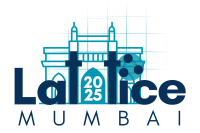Speaker
Description
We present our latest results on charmonium states $J/\psi(1S)$, $\psi(2S)$, $\eta _c(1S)$, $\eta _c(2S)$, $\chi _{c0}(1P)$ and $\chi _{c1}(1P)$ above the pseudo-critical temperature, using extended operators [1] on $N_x=64$, $N_\tau =16-32$ HISQ lattices using Wilson Clover fermions.
The charmonium states at zero temperature are well described by the heavy quark anti-quark potential. At finite temperature, screening of the heavy quark anti-quark potential was suggested as the cause of quarkonium melting in quark gluon plasma (QGP). Perturbative QCD calculations within potential non-relativistic QCD (pNRQCD) on the other hand do not lead to a screened potential in general, and the thermal correction to the potential also has an imaginary part.
Using extended operators, we are able to project much better into the lowest states of interest, which is needed due to the short extent in temporal direction at finite temperature, which otherwise is obscured by the continuum contribution. These results show a picture of no shift in the overall energy of the charmonium states, similar to the results from NRQCD for bottomonium [2] or for the potential extracted from Wilson line correlators [3].
Instead, all of these results show a picture of the spectral function broadening as the temperature increases, and the distance between the quarks increases. We use the vacuum wave function of different charmonium states and the imaginary part of the potential obtained by us on the lattice [3] to estimate the size of in-medium widths of $J/\psi(1S)$, $\psi(2S)$, $\eta _c(1S)$, $\eta _c(2S)$, $\chi _{c0}(1P)$ and $\chi _{c1}(1P)$ at finite temperature and compare with lattice results.
[1] Rasmus N. Larsen, Peter Petreczky, work in progress
[2] Rasmus N. Larsen, Stefan Meinel, Swagato Mukherjee, Peter Petreczky, Phys. Lett. B 800 (2020), 135119
[3] Alexei Bazavov, Daniel Hoying, Rasmus N. Larsen, Swagato Mukherjee, Peter Petreczky, Alexander Rothkopf, Johannes Heinrich Weber, Phys. Rev. D 109 (2024) 074504
| Parallel Session (for talks only) | QCD at nonzero temperature and density |
|---|

